|
|
home
contact
biograph
latest events & news
purchase or commission work
request free estimate
browse archived work
|
|
|
|
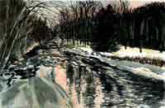
artwork and services
|
|
galleries of artwork |
 portfolio
of watercolour, pastel, collage, mixed media and
photography portfolio
of watercolour, pastel, collage, mixed media and
photography |
|
galleries of illustration |
 portfolio
of pen and ink, water media, and
digital paintings portfolio
of pen and ink, water media, and
digital paintings
|
attention
art directors:
Free cover art! |
Attention!:
 art editors
editors of poetry chapbooks,
literary journals,
small presses,
and self-publishing authors:
art editors
editors of poetry chapbooks,
literary journals,
small presses,
and self-publishing authors:
my
current work is available free of charge
to use for your cover art in exchange for 5 copies of
your book.
Or commission a
unique cover or illustrations at reasonable rates
|

books, essays, poems
|
Condensed Matter and Other States of Mind
- A Collection of poems
by Douglas A. Fowler . “Traveling cross-country
or in his back yard, Doug Fowler sees lovingly
every whisper of life from hard rock to soft
flowers, from reliable laws of nature to the
randomness of spilled coffee.” T.Saska...
 read
more read
more
No War No More -Edited
by
Arya F. Jenkins We take a stand
for peace with this collection of poems
and art, and featuring an essay by Staughton
Lynd...
 read
more read
more
WNWG Presents -
collection of stories by
WNWG, a unique writing club based
in Youngstown, Ohio, who invite you on an adventure
through their oft-twisted mindscape...
 read
more read
more
Greenwood/Blue
Lotus Press - GWBLPress,
formed in the Mahoning Valley, Ohio, is rooted
in a Buddhist, environmentalist and social consciousness...
 read
more read
more
WNWG Illustrations
- artwork commissioned by Youngstown Writers
Group...
 see
more see
more
|
|
|
|
|
|
studio >
galleries >
photography > alternative
> how-to
cyanotype paper-negative photography
|
John Beaver invented putting a very simple lens in front
of the paper & letting sunlight come through the lens
for a really long time to get a picture on the paper.
A way to quickly see this is to hold a magnifying lens
out at some bright outdoor scene (or indoors at a lit
light bulb) and then move it around until you can focus
an upside-down image of the scene (or the light bulb)
on a heavy white piece of paper. You have to move them
around a lot but eventually you'll get the small wide-angle
image. That's what a camera does. What you just did
was find the focal length of that particular magnifying
lens.
see cameras
paper-negative photographs
cyano van
You set it up in a light-tight "camera" body just as
you would any light sensitive film or paper... I learned
all this from Beaver and his explanation continues here:
About the Cyanotype Photonegative
Process
"Cyanotype is one of the oldest photographic printing
processes. Similar to the blueprint process, light
sensitive iron salts give a blue negative image
on a piece of treated paper. Unlike the much more
sensitive silver salts of traditional photographic
emulsions, the cyanotype iron salts are sensitive
only to ultraviolet light. For this reason cyanotype
is usually used only to make contact prints from
large-format negatives.
Here I have used cyanotype print paper as the negative
itself. A fast lens focuses light directly onto
the treated paper. The paper negative image that
results is then scanned and digitally reversed.
A color reversal yields an amber color - the complement
of the prussian blue negative.
Normal camera lenses cannot be used, as they are
coated to block ultraviolet light. For most of these
images I have used a homemade camera. The "Juliecam
2" is made from one of those plastic boxes that
35mm slides often come back in from the processor.
You know - the ones with the slip on, translucent
lids. This lid works perfectly as a view-camera-like
ground glass viewing screen. The lens, a simple
50mm f/1.5 double convex magnifying glass, is cemented
over a hole in the bottom of the box. 2" x 3" pieces
of cyanotype paper are taped to a sheet metal film
holder, which is held onto the inside of the lid
by a refrigerator magnet. Exposures are, typically,
5-10 minutes in bright sunlight.
A few of the images were made with an old 9x12cm
folding camera. The original lens has been replaced
with a simple, double convex f/3.5 magnifier. It
takes about 20-30 minutes in bright sunlight to
get a good exposure." {{{{Depending on your lens
you can get away with 1 – 2 HOURS at times….you
have to test it.}}}}(DML)
see
Beaver's cyano photographs gallery
Beaver Two
Beaver Three
back to the top
Beaver continues his discussion
in his article:
CYANOTYPE PHOTONEGATIVE PHOTOGRAPHY
"...I came up with this photographic process while working on
Astronomy: Images, Ideas and Perspectives,
an art and astronomy exhibition that first showed
in Waupaca, Wisconsin. The exhibition was a collaboration
between myself and the artist Judith Baker, Associate
Professor of Art at University of Wisconsin – Fox
Valley. Cyanotype seemed a natural tie-in for representing
the Sun, as the cyanotype process is sensitive only
to ultraviolet light, of which the sun is the most
obvious source. At first I made large format cameras
with either huge plano-convex lenses (I teach physics,
so such things are lying around the lab) or with
multiple smaller lenses. The idea was that the original
negative would be the picture. Eventually though,
I realized that the images were more interesting
when scanned and then reversed digitally. Several
aspects of this process make it an appealing technique:
• The inevitably long time exposures give it
a kinship with pinhole photography. No shutter
is needed, and all motion disappears from the
picture.
• The use of a fast, simple magnifier for a
lens gives an unusual image that naturally blurs
toward the edge (one way in which this process
is decidedly unlike pinhole photography).
• The grain of the paper adds interesting texture
to the image. The overall effect is not unlike
that of a lithograph.
• The complement of the cyanotype Prussian blue
color, upon digital reversal, yields appealing
amber and sepia tones.
• The low sensitivity of cyanotype means no
darkroom is needed. The unexposed cyanotype
“film” can be stored safely in your pocket,
and handled under normal incandescent room lighting,
or even fluorescents or daylight shade for brief
periods.
• The only chemical needed to develop the negatives
is good old H2O.
• Suitable cyanotype paper is available at many
toy stores, under the trade name Solargraphics®.
{{{ I have found it under NaturePrint.}}}} (DML)
It is marketed as a toy for children to make
shadow prints. The cost is only a few cents
per exposure.
• If you want to make your own photographic
emulsions, there is no simpler process than
cyanotype.
I believe it is also useful as a technique for beginners."
John also had his latest how-to article published in
a camera magazine.
A review I wrote of work on display in an Appleton,
WI, gallery in 2002:
A Definite Pursuit Of Uncertainty: Beaveranotypes These
images are ghostly, haunting…even mesmerizing. He has
seized the common and the ordinary about him and bestowed
a mysterious history upon them. These places, figures
and objects seem to be recorded from a visit to the
edge of reality. Beaver shows us a world we might have
only sensed somewhere in the layers of our subconscious;
perhaps we've seen these things and places in a dream...somewhere
at the edge of waking & asleep. We can't quite remember
where. Maybe it's what we saw once out of the corner
of our eye...and it slid away as soon as we turned to
gaze full upon it. These images do physically slide
under our inspection, moving forward and back in their
surfaces, it's here…now it's there…out there…over there.
The mood of the works is almost entirely one of hints.
We peer through the veil Beaver has swept over his world,
wondering. And we have to cling to the center, the only
stable ground, here there is focus—we've only this tunnel-like
vision to work with. Leave it and move outward toward
the edges and all dissolves under our feet. The intriguing
graininess draws the eye in. It's a texture to relish
and savor...giving room to dream and speculate, play
in, float away in. Worry about. Yes, worry, for there's
Being Here, there's memory, nostalgia, mystery, intrigue,
sadness, loss, fading-away-ness, intransigency... fuzz
of vision and blurriness of heart. So one worries: Is
this the only record of this bit of life? Is this all
we have? What the heck was it about? What went on...
and the sinking feeling that we'll never exactly find
out...
Process is almost everything for this photographer.
For him, seeking out a process becomes an unconscious
search for a language to speak his visions. Technique
becomes the catalyst inserted into the chemical soup
of the art-making part of his brain.
Ferro-types and heliographics are other terms applied
to these works.
Since this process often can take up to four hours for
a single image to materialize, a certain tree is a frequent
subject because it is one of the more captivating subjects
a few steps from his office. The photographic process
is free to amble along at its painstakingly slow pace
under the ultraviolet rays of the sun while inside the
photographer can attend to the business of teaching
physics and astronomy."
back to the top
The Columbus Dispatch review of the Columbus show:
Copyright 2004 Columbus Dispatch (Ohio)
July 11, 2004 Sunday, Home Final Edition
REVIEW: OHIO ART LEAGUE;
TECHNIQUE MIXES PAST WITH PRESENT, NEAR WITH FAR
Christopher A. Yates, for the Columbus Dispatch
John Beaver's work is an inquisitive union of the antique and contemporary.
He combines cyanotype, an early photographic printing
process, with computer-aided digital photography.
Easily identified by its rich blue color, the cyanotype
was invented in 1842 by Sir John Herschel. The process
involves coating paper with a solution of light-sensitive
salts (ferric ammonium citrate and potassium ferricyanide).
Placed directly under a negative and exposed to
full sunlight, the coated paper records a positive
or contact print image. Water stops the process.
Simpler and much cheaper than the method used to
produce albumen or silver-gelatin prints, the technique
was a favorite of late 19th-century photographers
eager to make inexpensive proofs of their work.
Beaver uses the traditional cyanotype printing process
in reverse. With specially constructed homemade
cameras, he produces what he calls "cyanonegatives."
By scanning the negatives on a computer and reversing
the contrast, he reveals a positive image. The process
changes the color from blue to sepia. In the diptych
Golden Rod , Beaver displays the transformation.
While staying true to the antique method, he uses
a technique that allows him to change scale and
manipulate the image to some degree. Curiously,
the computer serves as a method to produce prints
as inexpensive as those of his 19th-century counterparts.
Two forces are at play in Beaver's imagery. Time,
always a concern in photography, becomes manifest
as he produces his cyanonegatives. Long exposures
eliminate motion. Details fall away as edges and
sharp contrasts become more pronounced. This effect
and his choice of subject matter suggest studied
meditation. Images such as
Chair,
The Bird Cage
and St. Mary's
Church become visual icons with a host of
interpretive possibilities. Thoughts of location,
history, support, bondage and faith emerge.
The other force prominent in his work is an examination
of the physical world from the macro to the micro.
Moving from a specific object or place, Beaver reduces
his imagery to its essential form. On close examination,
one sees surface texture and the brush strokes left
from hand-sensitizing his paper. The effect is painterly,
with an air of chance and unpredictability.
In Trees and Ice
#2 , brushstrokes form a vignette around
a copse of distant trees. The effect is a dialogue
between near and far. Other pieces rely on segments
or parts of a whole. In
Pond, Green Bay,
a union of eight images produces a grand, panoramic
view of an ordinary scene.
Technical and visual experimentation guide Beaver's
hand. Drawing from the past and the present, his
work is strong and thought-provoking.
Review on Absolute Arts' website
of Beaver's Show in Columbus, Ohio:
Ohio Art League show announcement
Tears of Rage:
Cyanonegative and New Antiquarian Photography, John
Beaver curated by Teresa Saska 2004-07-05
until 2004-07-31 Columbus, OH, USA
Ohio Art League
www.oal.org
The Ohio Art League is pleased to present Tears
of Rage: Cyanonegative and New Antiquarian Photography,
John Beaver curated by Teresa Saska, in their July
Member Curated Exhibition. The exhibition will be
on view July 3 - 31. John Beaver writes: "I have
always been fascinated by the beyond-the-snapshot
possibilities of photography. For much of my photography
I use a unique process that combines cyanotype -
one of the oldest of photographic processes - with
homemade cameras and modern digital scanning and
printing."
Beaver continues, "Traditionally, cyanotype has
been used only for making contact prints from large-format
negatives. With the advent of modern digital scanning
and printing technology, I discovered that it is
now possible to use this process directly in the
camera, as the negative "film" itself. Since normal
camera lenses block the kind of light cyanotype
responds to, I have to make my own cameras for what
I call Cyanonegative Photography. The paper negative
image that results is then scanned and digitally
reversed and printed. Color reversal turns the strident
Prussian Blue of the cyanotype original to amber
and sepia tones. I am especially drawn to the painterly
qualities of this photographic process, to the odd
combination of the new and the antiquarian, and
to the magnification of tiny, non-photographic details.
It appeals to my inner nerdy-child-peering-at-pond-scum-through-a-microscope."
Review of John Beaver's cyanonegative photography
by Diana Ludwig:
"The mood of the works is almost entirely one of
hints. We peer through the veil Beaver has swept
over his world, wondering. And we have to cling
to the center, the only stable ground; here there
is focus -- we've only this tunnel-like vision to
work with. Leave it and move outward toward the
edges and all dissolves under our feet. The intriguing
graininess draws the eye in. It's a texture to relish
and savor…giving room to dream and speculate, play
in, float away in. Worry about. Yes, worry, for
there's Being Here, there's memory, nostalgia, mystery,
intrigue, sadness, loss, fading-away-ness, intransigency….
fuzz of vision and blurriness of heart. So one worries:
Is this the only record of this bit of life? Is
this all we have? What the heck was it about? What
went on… and the sinking feeling that we'll never
exactly find out…"
back to the top
These are the cameras that I (DML)
made which were used to take the alternative photos
on this website |

|
Click images
for larger view.
A removable metal plate is fashioned to fit inside, that you fasten your paper
to, in the shade, or in the house. The lens holder (i.e.
lid) is the part I take off, only because I fix the
focal plane in place (i.e. tape it). You can use a strong
magnet to hold the metal plate to the back cover.
|
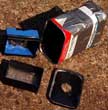
|
Cameras opened up, on left is that one's focusing surface,
and on the right is the lens of the longer camera. |

|
There's a translucent cover of some type at the back
of each that acts as your "viewfinder" (focus your image
on it ). |

|
A magnet is used to hold the metal
plate to the plastic rear cover. The plates are can
metal, they just look blue with reflection |

|
all my cameras |

|
A traditional cyanotype made by laying natural materials
on the paper and exposing it to the sunlight. |

|
Another traditional cyanotype that was scanned and reversed
digitally, of a dragonfly and a
dobsonfly |

|
A traditional cyanotype that was edited digitally (of
a dead mole and some ground-ivy leaves). |

|
A traditional cyanotype that was edited digitally a
lot more (the same dead mole and more ground-ivy leaves). |
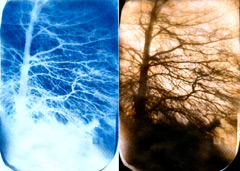
This shows the original of a small paper negative doing
the same process as above but putting the paper behind
a lens. Original on the right and on the left the reversal
of the colours via the invert tool on an imaging program. |
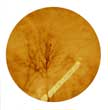
|
The long ones I take with the large metal cans often
burn in the path of the image of the sun as it moves
across the sky and the paper negative. And the largest
image will be round of course, although you can still
just use a square of paper. |
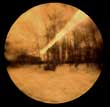
|
Again this is the sun burning. |
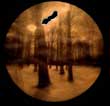
back to the top |
Click images
for larger view.
...and it was on fire when I opened my camera-can here.
The sun actually burnt a hole in the paper. (remember
again burning ants with that magnifying glass....) |
|
|

.jpg)